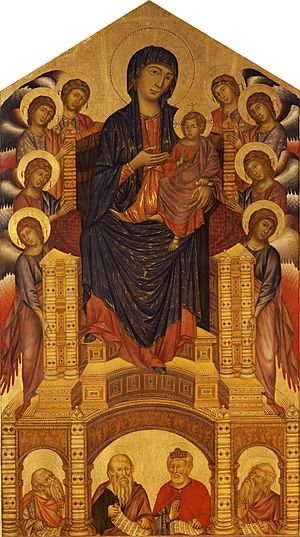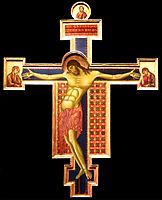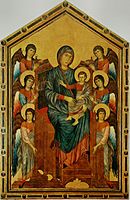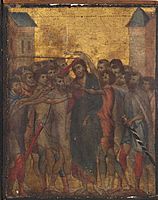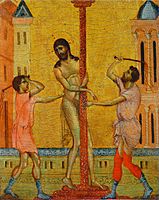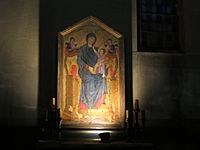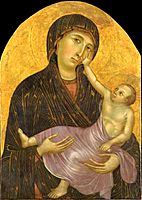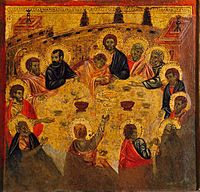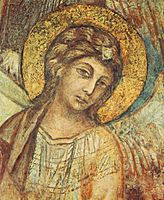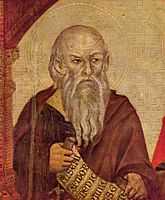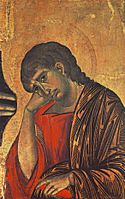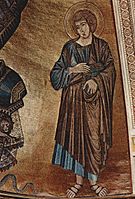Cimabue facts for kids
Cimabue, born around 1240 and dying in 1302, was an Italian painter and designer of mosaics from Florence. He was also known as Cenni di Pepo or Cenni di Pepi.
Cimabue is seen as one of the first great Italian painters to move away from the old Italo-Byzantine art style. At that time, most medieval art showed scenes and figures that looked flat and very styled. But Cimabue's paintings showed figures with more realistic shapes and shading, making them look more lifelike than other artists' work of his time.
Contents
Life of Cimabue
We don't know much about Cimabue's early life. He was born in Florence and passed away in Pisa. He might have learned his skills in Florence from teachers who were influenced by Byzantine art.
An art historian named Pietro Toesca believed that the Crucifixion in the church of San Domenico in Arezzo was painted by Cimabue around 1270. This makes it his earliest known work that started to break away from the Byzantine style. In this painting, Jesus is shown bent, and his clothes have golden lines, a style that was introduced by another artist, Coppo di Marcovaldo.
Around 1272, Cimabue created another Crucifix for the Florentine church of Santa Croce. This artwork was bigger and more advanced than the one in Arezzo.
There's a famous story about Cimabue meeting a 10-year-old boy named Giotto (around 1277). The story says Cimabue saw Giotto drawing his sheep on a smooth stone with a rough rock. He asked Giotto to come and live with him to learn painting. Giotto agreed with his father's permission. During Giotto's training, he supposedly painted a fly on a portrait Cimabue was working on. Cimabue tried to swat the fly away several times before realizing it was a trick! However, many modern experts now think that Giotto was not actually Cimabue's student.
Around 1280, Cimabue painted the Maestà. It was first shown in the church of San Francesco in Pisa, but now it's in the Louvre Museum. Many artists, including Duccio di Buoninsegna and Giotto, later used this style in their own works. Other paintings from this time include a Flagellation (Frick Collection), mosaics for the Baptistery of Florence, and the Maestà at the Santa Maria dei Servi in Bologna.
When Pope Nicholas IV became pope, Cimabue worked in Assisi. In the Lower Basilica of San Francesco, he painted a fresco called Madonna with Child Enthroned, Four Angels and St Francis. Part of this painting is now missing.
Cimabue was later asked to decorate the apse (the curved part behind the altar) and the transept (the cross-shaped part) of the Upper Basilica of Assisi. He painted scenes from the Gospels and the lives of the Virgin Mary, St Peter, and St Paul. Sadly, these paintings are now in poor condition because the bright colors he used have faded over time.
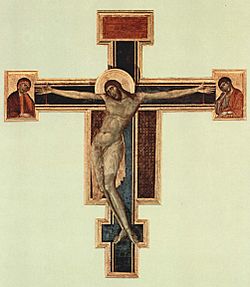
The Maestà of Santa Trinita, painted around 1290–1300, was originally for the church of Santa Trinita in Florence. It is now in the Uffizi Gallery. The softer look of the figures in this painting suggests that Cimabue was influenced by Giotto, who was already a well-known painter by then.
Cimabue spent the last part of his life, from 1301 to 1302, in Pisa. There, he was asked to finish a mosaic of Christ Enthroned in the city's cathedral. Cimabue created the part of the mosaic showing St John the Evangelist. This is the only artwork we know for sure was made by him. Cimabue died around 1302.
Cimabue's Character
According to a writer named Vasari, Cimabue was a very proud painter. If anyone pointed out a mistake in his work, or if he noticed one himself, he would immediately destroy the painting, no matter how valuable it was.
His nickname, Cimabue, means "bull-head." It might also mean "someone who crushes the views of others." This comes from the Italian word cimare, which means "to top" or "to blunt." This second meaning is similar to how the famous writer Dante was described, as someone who didn't like criticism.
Cimabue's Legacy in Art
For a long time, Cimabue was seen as the last artist of an old era, before the amazing changes of the Italian Renaissance began. As early as 1543, Vasari wrote that Cimabue "was, in one sense, the main reason painting was renewed." But he also added that "Giotto truly outshone Cimabue's fame, just like a bright light outshines a much smaller one." This means Giotto became much more famous.
Cimabue in Dante's Divine Comedy
In his famous poem, Purgatorio, Dante writes about how quickly people forgot Cimabue's fame when Giotto's new art style became popular:
Oh, how quickly human glory fades,
unless a time of darkness follows!
In painting, Cimabue thought he was the best,
but now it's Giotto everyone praises,
so that the other's fame is dimmed.
Market for Cimabue's Art
On October 27, 2019, a painting called The Mocking of Christ was found in the kitchen of an elderly French woman. It sold for €24 million (about $26.6 million) at an auction. This was a new record for a medieval painting sold at auction, selling for four times more than expected. An anonymous buyer from northern France bought it.
Gallery
-
Maestà (c. 1280), Louvre, Paris
-
Virgin and Child with Two Angels (c. 1280), National Gallery, London
-
The Flagellation of Christ (c. 1280), Frick Collection, New York
See also
 In Spanish: Cimabue para niños
In Spanish: Cimabue para niños


